Context
- On November 11, 2025, Bhutan celebrates the 70th birthday of former King Jigme Singye Wangchuck (K4) — one of the most respected monarchs in South Asia.
- The day also coincides with Prime Minister Narendra Modi’s visit to Thimphu, symbolising the depth of India–Bhutan friendship.
- The article uses this occasion to reflect on K4’s leadership, his modernisation of Bhutan, and his enduring contribution to India–Bhutan relations.
Analysis: The Sage King and His Legacy - Jigme Singye Wangchuck (K4) ascended the throne at 17 and abdicated in 2006 for his son Jigme Khesar Namgyel Wangchuck (K5).
- Revered as the Bodhisattva King, he is credited with introducing the globally admired Gross National Happiness (GNH) model — a development vision combining material progress with spiritual well-being.
- His leadership dragged Bhutan into the 21st century, promoting education, environmental protection, and cautious opening to the outside world while preserving cultural identity.
India–Bhutan Ties: Built on Trust and Shared Values - PM Modi has consistently prioritised Bhutan, making it his first foreign visit after assuming office in 2014 — demonstrating the essence of India’s Neighbourhood First Policy.
- India and Bhutan share deep civilisational, cultural, and strategic ties.
- Modi’s presence at the King’s 70th anniversary is symbolic — it reiterates India’s commitment to Bhutan’s stability, prosperity, and independence.
K4’s Contribution to Modern Bhutan–India Relations - During K4’s reign, Bhutan transitioned from isolation to regional engagement — with India playing a mentoring yet non-interfering role.
- It was under K4 that the Border Roads Organisation (BRO) constructed Bhutan’s major roads, ensuring internal connectivity.
- K4 also realised the potential of Bhutan’s rivers as a renewable resource — promoting hydropower cooperation with India, which became the cornerstone of the bilateral relationship.
Hydropower Diplomacy – The Pillar of Bilateral Ties - Hydropower remains the backbone of India–Bhutan relations.
- The upcoming Punasangchhu-II Hydroelectric Project (1,020 MW), to be jointly inaugurated by PM Modi and K5, reflects the ongoing cooperation.
- Earlier projects like Chukha (1988), Kurichhu (2001), and Tala (2006) followed a model where India funded, built, and purchased electricity from Bhutan at agreed rates.
Beyond Energy – Expanding the Development Partnership - India continues to assist Bhutan in community development, education, healthcare, and digital infrastructure.
- India supports Bhutanese projects for upgrading monasteries, building roads, and creating IT-enabled governance systems.
- These initiatives show India’s commitment to inclusive development cooperation, not limited to economics.
Strategic and Security Cooperation - Bhutan plays a key role in India’s Himalayan security architecture, serving as a buffer between India and China.
- K4 personally oversaw Operation All Clear (2003), where Bhutan’s Army expelled Indian insurgent groups (ULFA, NDFB, KLO) operating from its southern jungles — a major gesture of trust toward India.
- His son, K5, continues to seek K4’s guidance on national security and relations with China.
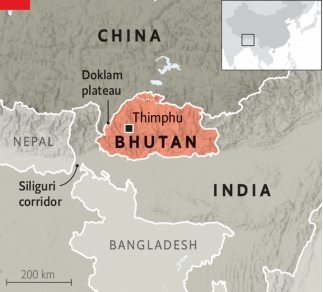
Strategic Relevance: - India–Bhutan cooperation ensures security along the sensitive Doklam plateau, a key flashpoint near the India–China–Bhutan tri-junction.
- This reflects mutual trust in defence coordination and policy alignment against external threats.
UPSC Mains Q.
“India–Bhutan relations stand as a model of trust-based diplomacy in South Asia. Examine the significance of hydropower cooperation and strategic alignment in strengthening these ties.”
Why Access to Knowledge is Crucial for Innovation

GS Paper: GS-III – Indian Economy – Growth, Development, and Inclusive Growth Context The 2025 Nobel Prize in Economics was awarded to Joel Mokyr, Philippe Aghion, and Peter Howitt for their work on the relationship between knowledge, technological change, and economic growth. This article explores why free access to knowledge and information is vital for innovation and sustained economic development, and how social barriers, such as caste or limited educational access, and automation trends can restrict it.Detailed Analysis 1. Mokyr’s Model of Knowledge and Growth
- Joel Mokyr distinguishes between two types of knowledge:
- Propositional Knowledge: Scientific and theoretical understanding of natural phenomena.
- Prescriptive Knowledge: Practical know-how — techniques and methods to apply scientific knowledge.
- Economic growth depends not merely on possessing knowledge but on society’s ability to disseminate and utilise it.
2. Free Flow of Knowledge as a Social Process - Technological advancement is not only economic, but also a social and cultural process.
- Innovation thrives where social norms encourage the sharing of ideas and where access to education and information is widespread.
- Conversely, when information is restricted (through hierarchies, bureaucracy, or elitism), growth stagnates.
3. Caste System and Knowledge Restriction in India - The caste system historically confined education and knowledge to a limited elite.
- Post-Independence policies like reservations tried to correct this imbalance, but quality education still remains out of reach for many.
- The fragmentation of caste further limits social interactions and innovation networks.
- Those deprived of knowledge access cannot participate in or benefit from innovation.
4. Automation and Knowledge Inequality - The rise of AI and automation is transforming labour markets.
- Routine tasks are being taken over by machines, while humans occupy either high-skilled or low-service jobs.
- This creates job polarisation — a divide between skilled workers (with access to new techniques) and unskilled workers (excluded from them).
- When the majority of workers lack exposure to modern technological knowledge, the diffusion of innovation suffers.
5. The Way Forward – Democratizing Knowledge - Breaking social barriers (like caste or class) and improving education access is vital for inclusive innovation.
- Government policies must:
- Ensure affordable and quality education.
- Facilitate knowledge-sharing ecosystems (research, open access, community learning).
- Reduce digital divides and promote technological literacy.
Democratization of knowledge is not opposed to economic efficiency—it is the foundation for
faster, inclusive growth.
UPSC Mains Q. “Democratization of knowledge is essential for sustaining innovation and inclusive economic growth.” Discuss with reference to India’s socio-economic context.
High-Intensity Explosion in Capital Kills at Least 9 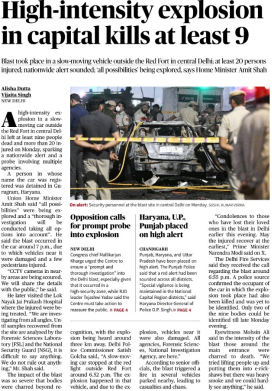
Syllabus: GSIII – Internal Security: Challenges to Internal Security through Terrorism; Role of State and Non-State Actors; Institutional Mechanisms for Disaster & Crisis Management
Context A high-intensity explosion occurred in a slow-moving vehicle near the Red Fort in central Delhi, killing at least nine people and injuring over twenty others. The blast triggered a nationwide alert and a multi-agency investigation involving the National Investigation Agency (NIA), Forensic Sciences Laboratory (FSL), and National Security Guard (NSG).
Given the sensitive location and timing, authorities have not ruled out any possibility—including terrorist activity or sabotage.
Analysis 1. Nature of the Incident
- The blast occurred around 7 PM outside the Red Fort, a high-security heritage and tourist zone.
- CCTV footage and forensic samples are being examined.
- Authorities detained one individual linked to the vehicle’s registration in Gurugram, Haryana.
- Eyewitnesses reported severe flames, shattered nearby vehicles, and widespread panic.
2. Immediate Administrative and Political Response - Union Home Minister Amit Shah assured a “thorough investigation considering all angles.”
- Prime Minister Narendra Modi expressed condolences and directed officials to ensure medical care for victims.
- Opposition leaders, including Mallikarjun Kharge and Tejashwi Yadav, demanded transparency and accountability in the probe.
3. Security Measures & Inter-State Coordination - Red Alert issued across Delhi, Haryana, Punjab, and Uttar Pradesh.
- State police directed to enhance vigilance at public gatherings, metro stations, and key installations.
- Reinforcement of intelligence-sharing channels among central and state agencies.
4. Larger Internal Security Concerns This incident underlines: - The continued vulnerability of urban centers to high-intensity attacks.
- The need for stronger preventive intelligence mechanisms, including AI-based surveillance and predictive policing.
- The importance of inter-agency coordination and rapid response capacity under the National Crisis Management Committee (NCMC) framework.
- Lessons from past incidents such as the 2008 Delhi serial blasts and 2011 High Court bombing, which led to procedural reforms but also highlighted persistent intelligence gaps.
UPSC Prelims Q. Which of the following are components of India’s internal security framework?
1. National Investigation Agency (NIA)
2. National Security Guard (NSG)
3. Intelligence Bureau (IB)
4. Central Industrial Security Force (CISF) Select the correct answer using the code below:
(a) 1 and 2 only
(b) 1, 2 and 3 only
(c) 1, 2, 3 and 4
(d) 2 and 4 only
Answer: (c) 1, 2, 3 and 4
SC Says Women Are the ‘Largest Minority,’ Notes Their Receding Presence in Parliament
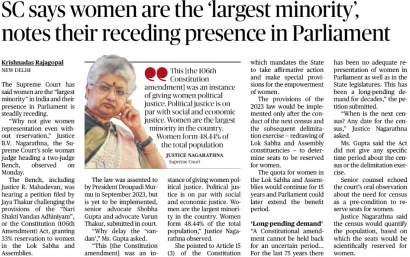
Syllabus: GS Paper II – Polity & Governance: Representation of Women, Constitutional Provisions, and Political Empowerment Context The Supreme Court has recently observed that women are the “largest minority” in India, constituting 48.44% of the population, yet their representation in Parliament remains dismally low and is receding.
Justice B.V. Nagarathna, while hearing a petition regarding the 106th Constitutional Amendment (Nari Shakti Vandan Adhiniyam), questioned why women should not be given representation even without reservation, and emphasized that political justice is as vital as social and economic justice. 106th Constitutional Amendment Act, 2023 (Nari Shakti Vandan Adhiniyam)
- Provides for 33% reservation of seats for women in:
- Lok Sabha (Lower House of Parliament)
- State Legislative Assemblies
- Reservation to be implemented after the next Census and subsequent delimitation exercise.
- Valid for 15 years from the date of implementation (can be extended by Parliament).
- Seeks to achieve political justice as part of the Preamble’s broader goals of equality.
Article 15(3) - Article 15(3) of the Constitution empowers the State to make special provisions for women and children.
- It forms the constitutional foundation for affirmative action, including reservations in education, employment, and political representation.
Historical Representation of Women in Lok Sabha | Lok Sabha | Year | % of Women MPs | Key Note |
| 1st Lok Sabha (1952) | 22 women out of 489 | 4.5% | Early participation post-Independence |
| 6th Lok Sabha (1977) | 19 women out of 544 | 3.5% | Drop in representation |
| 17th Lok Sabha (2019) | 78 women out of 543 | 14.4% | Highest ever, yet far below parity |
Despite steady social progress, women’s representation has remained below 15%, far lower than global democracies like the UK (34%), USA (28%), or Rwanda (61%).
Analysis 1. Women as the “Largest Minority” - Justice Nagarathna’s statement reframes women’s underrepresentation as a democratic deficit, not merely a gender issue.
- Despite numerical majority in population, women function as a “minority” in power structures, especially in legislatures and policy-making bodies.
2. Delay in Implementation - The Act’s implementation is linked to two future exercises:
1. Next Census 2. Delimitation (redrawing of constituencies)
- No definite timeline has been provided, causing public concern that the law’s operationalization may be indefinitely delayed.
3. Political Justice & Democratic Balance - The Constitution envisages political justice alongside social and economic justice (Preamble).
- Without women’s participation in law-making, democracy remains structurally incomplete.
- The delay undermines India’s global commitments under the Convention on the Elimination of All Forms of Discrimination Against Women (CEDAW).
4. Long-Pending Demand - The idea of women’s reservation has been debated for over three decades, since the 73rd and 74th Amendments (1992) ensured 33% reservation for women in Panchayati Raj Institutions.
- The Women’s Reservation Bill (first introduced in 1996) faced repeated hurdles until it finally became the 106th Constitutional Amendment in 2023.
UPSC Prelims Q. With reference to the 106th Constitutional Amendment Act, 2023, consider the following statements: 1. It provides one-third reservation for women in the Lok Sabha and State Legislative Assemblies. 2. The reservation will come into effect immediately after Presidential assent. 3. It is based on the provisions of Article 15(3) of the Constitution. Which of the statements given above is/are correct?
(a) 1 only
(b) 1 and 3 only
(c) 2 and 3 only
(d) 1, 2 and 3
Answer: (b) 1 and 3 only
Petition in SC Says GenAI May Lead to Fake Case Laws
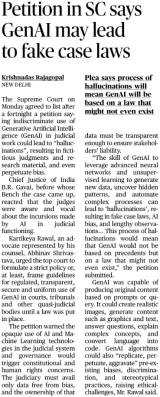
Syllabus: GS Paper II – Governance, Transparency, and Accountability Context A petition has been filed in the Supreme Court warning that the indiscriminate use of Generative Artificial Intelligence (GenAI) in the judicial system could result in “hallucinations”—AI-generated false or non-existent legal precedents, biased judgments, and erroneous research outcomes.
The petition urges the Court to establish guidelines and regulatory mechanisms for the safe, transparent, and accountable use of GenAI in judicial and quasi-judicial work.
Analysis
1. Background and Judicial Concern
- The petition was brought before Chief Justice of India B.R. Gavai, who acknowledged that judges were already aware of AI’s increasing presence in judicial research and functioning.
- Advocate Kartikeya Rawal, through counsel Abhinav Shrivastava, argued that unchecked AI integration could result in:
- Fictitious judgments,
- Misleading research citations,
- Algorithmic bias in judicial reasoning.
2. The “Hallucination” Problem - In AI terminology, “hallucination” refers to a system generating incorrect or fabricated information that appears convincing.
- The petition notes that GenAI might fabricate non-existent case laws or misinterpret statutes, leading to legal errors and erosion of judicial credibility.
- Such “hallucinated” case laws could influence judgments based on precedents that do not exist, creating a chain of misinformation within the judicial record.
3. Risks Identified by the Petitioner - Opacity in AI models: Lack of transparency in how GenAI generates its output can make accountability difficult.
- Bias perpetuation: AI systems trained on historical legal data may reinforce gender, caste, or class biases present in past judgments.
- Ethical and constitutional risks: Using unregulated AI tools in justice delivery could violate principles of fairness, due process, and equality before law (Article 14).
4. Call for Regulation - The plea urges the Supreme Court to frame guidelines for:
- Regulated, secure, and uniform use of GenAI in courts and tribunals.
- Ensuring transparency of AI datasets and stakeholder accountability.
- Establishing AI ethics frameworks for judicial and administrative institutions until Parliament passes a comprehensive law.
5. Larger Implications - AI offers benefits such as efficient case research, translation of judgments, and predictive analytics for case management.
- However, without human oversight and data validation, it risks creating a parallel system of algorithmic justice, undermining human reasoning and legal sanctity.
- The petition highlights the urgent need for a balance between innovation and constitutional safeguards in the age of AI governance.
UPSC Prelims Q. With reference to Generative Artificial Intelligence (GenAI), consider the following statements:
1. GenAI can produce original content such as text, images, and code using machine learning models.
2. The phenomenon of “AI hallucination” refers to AI generating false or fabricated information.
3. The Supreme Court of India has already issued binding regulations for GenAI use in courts. Which of the statements given above is/are correct?
(a) 1 and 2 only
(b) 2 only
(c) 1 and 3 only
(d) 1, 2 and 3
Answer: (a) 1 and 2 only
Brahmaputra, Teesta Rivers Eroding Land Faster than Ever in Bangladesh

Syllabus: GS Paper I – Geography: Physical Geography – Rivers, Climate Change & Glacial Melt
GS Paper III – Environment and Climate Change
Context Bangladesh, one of the world’s most climate-vulnerable countries, is witnessing rapid erosion of land along the Brahmaputra and Teesta Rivers, displacing thousands of families each year.
The article highlights how glacier melt in the Himalayas and erratic monsoon patterns—both driven by climate change—are accelerating riverbank erosion, destroying homes, crops, and livelihoods in northern Bangladesh’s Kurigram district.
About Brahmaputra and Teesta Rivers Brahmaputra River
- Origin: Chemayungdung Glacier near Kailash Range, Tibet (as Tsangpo).
- Course: Flows through Tibet → Arunachal Pradesh (as Siang) → Assam → Bangladesh (as Jamuna).
- Tributaries: Dibang, Lohit, Subansiri (in India); Teesta, Dhaleshwari (in Bangladesh).
- Significance: Supports agriculture, fisheries, and transport but causes massive floods and erosion annually.
Teesta River - Origin: Pahunri (Teesta Khangse) Glacier in Sikkim Himalayas.
- Course: Flows through Sikkim, West Bengal, and enters Bangladesh, joining the Brahmaputra.
- Importance: Lifeline for north Bengal and northern Bangladesh.
- Issue: Seasonal variability and upstream hydrological projects have reduced flow downstream, worsening erosion and siltation.
Glacial Sources - Both rivers are fed by Himalayan glaciers, which act as perennial sources of freshwater.
- Accelerated glacial melt, due to rising global temperatures, increases river discharge variability — intense floods in monsoon and reduced flow in dry seasons.
Detailed Analysis 1. Accelerated Riverbank Erosion
- The Brahmaputra and Teesta rivers are eroding land at unprecedented rates.
- Farmers in Kurigram (Bangladesh) are forced to relocate multiple times a year as islands (chars) disappear underwater.
- These chars are temporary landforms formed by river sediment but are highly unstable and easily eroded.
2. Climate Change as the Root Cause - Melting of Himalayan glaciers that feed the Brahmaputra and Teesta has increased glacial runoff, altering river hydrology.
- Erratic monsoons—arriving earlier, lasting longer, and bringing heavier downpours—further intensify erosion.
- The World Bank estimates 1 in 7 Bangladeshis could be displaced by climate-related disasters by 2050.
3. Socio-Economic Impact - Thousands of families lose land, crops, and homes annually.
- Women and children face heightened vulnerability — loss of safety, education, and access to sanitation in temporary shelters.
- Continuous displacement perpetuates poverty cycles and weakens resilience.
4. Adaptive Measures and Local Response - Local NGOs and communities are building raised homes and embankments, using sandbags (“geobags”) to stabilize riverbanks.
- Despite local innovations, national and global climate finance remains inadequate.
- Without international cooperation and cross-border river management, Bangladesh’s resilience may collapse.
5. Global Implications - The crisis mirrors broader South Asian climate vulnerability—shared river systems, population density, and poverty make adaptation difficult.
- As Bangladesh prepares for the U.N. Climate Summit (COP30) in Brazil, it serves as a warning of how glacial melt in the Himalayas has transboundary impacts on ecosystems and human settlements.
UPSC Prelims Q. With reference to the Brahmaputra River system, which of the following statements is/are correct? 1. The Brahmaputra originates from the Chemayungdung Glacier in the Kailash Range.
2. In Bangladesh, the Brahmaputra is known as the Jamuna.
3. The Teesta River is a major tributary of the Brahmaputra in Bangladesh. Select the correct answer using the code below:
(a) 1 and 2 only
(b) 1, 2 and 3
(c) 2 and 3 only
(d) 1 only
Answer: (b) 1, 2 and 3
Rural Unemployment Down, Urban Joblessness Up, Finds Government Survey
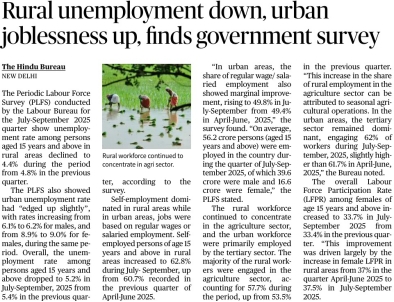
Syllabus: GS Paper III – Indian Economy: Employment, Growth, and Inclusive Development
Context The Periodic Labour Force Survey (PLFS) for July–September 2025, released by the Labour Bureau, shows a mixed trend:
- Rural unemployment rate (UER) has declined from 4.8% to 4.4%, reflecting seasonal agricultural employment.
- Urban unemployment rate has increased slightly, from 6.1% to 6.2% for males and from 8.9% to 9.0% for females.
Overall, India’s unemployment rate for those aged 15 and above fell marginally from 5.4% to 5.2%.
This highlights the continued rural dependence on agriculture and the stagnation of job creation in the urban tertiary sector.
About PLFS (Periodic Labour Force Survey)
- Launched by: National Statistical Office (NSO), Ministry of Statistics and Programme Implementation (MoSPI)
- Objective: To provide quarterly estimates of employment and unemployment indicators for urban areas and annual estimates for both rural and urban areas.
- Initiated in: 2017
- Key Indicators:
1. Labour Force Participation Rate (LFPR) 2. Worker Population Ratio (WPR) 3. Unemployment Rate (UER) 4. Type of employment (self-employed, regular wage/salaried, casual labour)
Key Terms 1. Labour Force Participation Rate (LFPR): The percentage of people aged 15 years and above who are either employed or actively seeking work. LFPR for females increased from 33.4% to 33.7%, mainly due to rising rural participation.
- Rural female LFPR rose from 37% (Apr–Jun) to 37.5% (Jul–Sep) 2025.
2. Unemployment Rate (UER): The percentage of people in the labour force who are willing and able to work but do not find employment.
Rural UER: 4.4% (down from 4.8%)
- Urban UER: 6.2% (up from 6.1%)
Analysis 1. Rural Trends: Seasonal Agricultural Absorption - The fall in rural unemployment is linked to agricultural operations during the Kharif season.
- Self-employment dominates rural areas, with 62.8% of rural workers self-employed (up from 60.7% in the previous quarter).
- Agriculture continues to employ 57.7% of the rural workforce, showing persistent agrarian dependence.
2. Urban Trends: Stagnation and Joblessness - Urban unemployment edged up slightly, reflecting slower job creation in the manufacturing and services sectors.
- The share of regular wage/salaried jobs increased marginally to 49.8%, but this improvement is limited.
- The urban tertiary sector remains dominant, employing 62% of urban workers (up slightly from 61.7%).
3. Gender Dynamics - Female participation in the labour force has improved, driven largely by rural women joining agricultural and self-employed work.
- However, urban female unemployment remains high at 9%, signaling a lack of white-collar opportunities.
4. Employment Quality Concerns - The rise in self-employment, though positive for engagement, may reflect disguised employment or low-income informal work, not genuine job creation.
- The data underscores India’s challenge of “jobless growth”, where GDP rises but formal employment opportunities remain stagnant.
UPSC Prelims Q. Consider the following statements regarding the Periodic Labour Force Survey (PLFS): 1. The PLFS provides quarterly estimates for both rural and urban areas. 2. The survey is conducted by the Labour Bureau under the Ministry of Labour and Employment. 3. It provides data on key employment indicators such as LFPR, WPR, and UER. Which of the statements given above is/are correct?
(a) 1 and 3 only
(b) 2 and 3 only
(c) 1 only
(d) 1, 2 and 3
Answer: (a) 1 and 3 only
Booker Prize Syllabus: GS Paper I — Art & Culture (Literary awards and contributions of Indian authors).
Context: Hungarian-British author
David Szalay won the
2025 Booker Prize for his novel
‘Flesh’, marking the first time a Hungarian-British writer received this prestigious literary honour.
Key Points - About: The Booker Prize is the world’s leading literary award for a single work of fiction.
- Founded: Established in the UK in 1969, initially for Commonwealth writers; now open globally to all English-language authors.
- Objective: To promote the finest in fiction by recognizing the best novel of the year written in English.
- Eligibility: Open to novels originally written in English and published in the UK or Ireland; self-published works not eligible.
- Prize Amount: Winner receives £50,000; shortlisted authors get £2,500 each.
- 2025 Winner: David Szalay for ‘Flesh’ — first Hungarian-British author to win.
- Notable Indian Laureates:
- V.S. Naipaul – In a Free State
- Salman Rushdie – Midnight’s Children
- Arundhati Roy – The God of Small Things
- Kiran Desai – The Inheritance of Loss (2006)
- Aravind Adiga – The White Tiger (2008)
Source: DD News
National Board for Wildlife
Syllabus: GS Paper III — Environment & Ecology (Conservation, statutory bodies, wildlife protection).
Context: The
Standing Committee of the National Board for Wildlife (NBWL) recently recommended
13 defence and paramilitary projects, mostly in
high-altitude protected areas of Ladakh and one in
Arunachal Pradesh, highlighting its role in balancing security and conservation needs.
Key Points - About NBWL: A statutory body established in 2022 under Section 5A of the Wildlife (Protection) Act, 1972.
- Role: India’s top advisory body on wildlife conservation, especially for projects in Protected Areas (PAs).
- Structure:
- 47-member board headed by the Prime Minister.
- Minister of Environment, Forest & Climate Change as Vice-Chairperson.
- Includes senior officials like the Chief of Army Staff, Defence Secretary, and Expenditure Secretary.
- 10 eminent conservationists/environmentalists nominated by the Centre.
- Member-Secretary: Additional Director General of Forests (WL) & Director, Wildlife Preservation.
- Functions:
- Promotes conservation and development of wildlife and forests.
- Advises governments on wildlife protection and policy matters.
- Controls poaching and illegal wildlife trade.
- Recommends management of national parks, sanctuaries, and PAs.
- Conducts Environmental Impact Assessments (EIA) of projects in wildlife areas.
- Publishes a biennial status report on India’s wildlife.
- Standing Committee:
- An independent body within NBWL with up to 10 members.
- Chaired by the Environment Minister.
- Focuses on land diversion and project clearances within protected areas.
- NBWL handles policy-level decisions, while Standing Committee handles project-level clearances.
Source: The Hindu
National Social Assistance Programme
Syllabus: GS Paper II — Government Policies & Social Justice (Welfare schemes for vulnerable sections).
Context: The
National Social Assistance Programme (NSAP) serves as a
key pillar of India’s social security system, providing direct financial and food support to
BPL households, elderly, widows, and persons with disabilities.
Key Points - Launched: In 1995 as a fully funded Centrally Sponsored Scheme.
- Objective: To extend financial assistance to individuals below the poverty line (BPL).
- Nodal Ministry: Ministry of Rural Development.
Sub-Schemes under NSAP 1.
Indira Gandhi National Old Age Pension Scheme (IGNOAPS):
o For citizens
60+ years from BPL families.
o
₹200/month (60–79 yrs) and
₹500/month (80+ yrs) as central assistance.
2.
Indira Gandhi National Widow Pension Scheme (IGNWPS):
o For
widows aged 40–79 years from BPL families.
o
₹300/month, and
₹500/month (80+ yrs) assistance.
3.
Indira Gandhi National Disability Pension Scheme (IGNDPS):
o For
persons with severe/multiple disabilities aged 18–79 years from BPL families.
o
₹300/month, and
₹500/month (80+ yrs) assistance.
4.
National Family Benefit Scheme (NFBS):
o Provides
₹20,000 lump sum to BPL households on the
death of the primary breadwinner (18–59 yrs).
5.
Annapurna Scheme:
o Provides
10 kg of free food grains/month to
senior citizens eligible under IGNOAPS but
not receiving a pension.
Significance: Strengthens
social safety nets and supports
vulnerable groups during financial hardships.
Source: PIB
Exercise MITRA SHAKTI-2025
Syllabus: GS Paper III —
Internal Security & Defence (Joint military exercises, counter-terrorism operations).
Context: Exercise MITRA SHAKTI-2025 is the 11th India–Sri Lanka joint military exercise held at the Foreign Training Node, Belagavi, Karnataka. It focuses on rehearsing sub-conventional operations under a UN Chapter VII mandate to strengthen bilateral defence cooperation.
Key points - Aim: Joint rehearsal of sub-conventional operations under Chapter VII of the United Nations mandate.
- Edition & Venue: 11th edition, conducted at Foreign Training Node, Belagavi, Karnataka.
- Participants (India): Contingent mainly from the RAJPUT Regiment with support from the Indian Air Force.
- Scope: Synergise joint responses for counter-terrorist operations and interoperability.
- Tactical drills: Practice of raids, search-and-destroy missions, and heliborne operations.
- Aerial & counter-UAS: Employment of drones and counter-unmanned aerial systems is included.
- Helipad & MEDEVAC drills: Joint rehearsal to secure helipads and perform casualty evacuation during operations.
- Skill exchange: Both armies will share best practices and conduct wide-spectrum combat skill drills.
- Significance: Enhances defence cooperation and operational coordination between Indian and Sri Lankan armies.
- Operational focus: Emphasis on tactical interoperability, rapid response, and evacuation procedures in counter-terror scenarios.
Source: PIB










